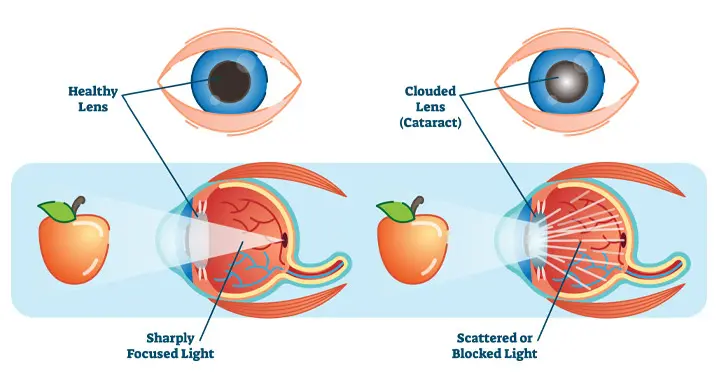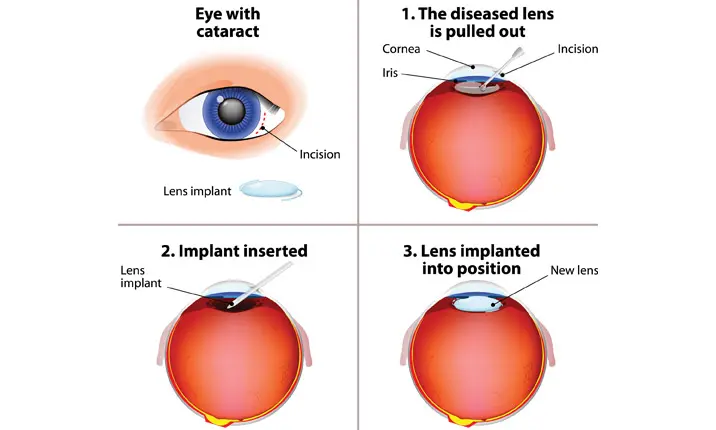Dr Leonard Ang, ophthalmologist practising at Mount Elizabeth Hospital, explains how modern cataract surgery can help you remove your cataract before it becomes worse.
In Singapore, more than 30% of people aged 45 and above have some degree of cataract. And by the time they reach 60 years old, 80% have cataracts.
What is a cataract?
Cataract is a condition where the natural lens of the eye becomes cloudy and the amount of light entering the eye is thus reduced. This, in turn, leads to blurred vision.
It is a slow, progressive blurring of the vision – both distant and near. Things appear less bright so your vision tends to be worse at night. You may also experience glares and haloes. A continued change in spectacle power may signify the progression of the cataract.
What are the causes of cataracts?
Most cataracts develop due to ageing or injury, changing the tissues that make up your eye's lens. Other causes of cataracts include inherited genetic disorders, other eye conditions, past eye surgery, medical conditions such as diabetes, and long-term use of steroid medications.
How cataracts form
Cataracts form in the lens, which is positioned behind the iris. Ageing and medical conditions make the lenses of the eyes become less flexible, less transparent and thicker. They also cause tissues within the lens to break down and clump together, clouding small areas within the lens. As cataracts continue to develop, the clouding becomes denser and involves a bigger part of the lens, resulting in visions becoming blurred.
Types of cataracts
- Nuclear cataracts. This cataract affects the centre of the lens and may at first cause more near-sightedness or even a temporary improvement in your reading vision. However, with time, the lens gradually turns more densely yellow and further clouds your vision. As the cataract progresses, the lens may turn brown, making it difficult to distinguish shades of colour.
- Cortical cataracts. This cataract begins as whitish, wedge-shaped opacities or streaks on the outer edge of the lens cortex. As it further develops, the streaks extend to the centre and interfere with the passing of light through the centre of the lens.
- Posterior subcapsular cataracts. This cataract starts as a small, opaque area usually near the back of the lens, right in the path of light. It often interferes with reading vision, reduces vision in bright light, and causes glare at hight. This type of cataract is often more progressive than other types.
- Congenital cataracts. This cataract occurs at birth or develops during childhood. It may be caused by genetic, infection or trauma in the womb or other medical conditions. The cataracts are usually removed soon after detection and therefore do not always affect vision.
Risk factors
- Age
- Diabetes
- Excessive exposure to sunlight
- Smoking
- Obesity
- High blood pressure
- Eye injury or inflammation in the past
- Eye surgery in the past
- Long-term use of steroid medications
- Excessive alcohol intake
Prevention
- Have regular eye examinations so cataracts and other eye problems can be detected early
- Stop smoking
- Manage other health problems, such as diabetes that can increase your risk of cataracts
- Consume a healthy diet that includes plenty of fruits and vegetables
- Wear sunglasses that block ultraviolet B rays when you are outdoors
- Drink alcohol moderately
What are the symptoms of cataracts
During the initial stages of cataract development, the cloudiness in your vision may only affect a small part of the eye's lens and you may be unaware of any vision loss. As the cataract grows larger, more noticeable symptoms occur, such as the following:
- Clouded, blurred or dim vision
- Increasing difficulty with vision at night
- Sensitivity to light and glare
- Need for brighter light for reading and other activities
- Seeing 'halos' around lights
- Frequent changes in spectacles or contact lens prescription
- Fading or yellowing of colours
- Double vision in a single eye
Because the symptoms are gradual and painless, many do not realise they have cataract until it becomes very advanced. As such, they end up undergoing cataract surgery when it becomes too late.
When the cataract is very advanced, complications may develop and the lens can become more unstable. Surgery would then significantly increase the risk of complications and reduce the success rate. The recovery is much longer and the visual result is likely to be poorer.
Hence, patients are advised not to delay cataract removal surgery.
How to treat cataracts?
Surgery is the only method to treat cataracts.
Cataract surgery
Cataract surgery is recommended if the cataract is impairing vision and affecting one's daily activities. Cataracts may also need to be removed if it is very dense and is likely to cause complications such as glaucoma. In severe cases of glaucoma, patients may lose their vision permanently.
Cataract surgery is now very advanced and can be performed as a day surgery under 30 minutes, and the patient can return home after the surgery.
Phacoemulsification cataract surgery
The modern method of removing a cataract is by phacoemulsification, which involves making a small incision at the edge of the cornea to soften and remove the cataract. The use of femtosecond lasers could make more precise incisions, create the central opening that holds the lens, and make cracks to allow easier removal of the cataract. An artificial lens (intraocular lens) is implanted immediately following the cataract removal and the wound often seals on its own without the need for stitches.
Intraocular lens
Advances in intraocular lens technology improved visual outcomes according to each patient's needs. This includes giving patients better vision, quality of life and greater convenience without the need for spectacles. All forms of refractive error in the eye can be corrected, including myopia (shortsightedness), astigmatism and presbyopia.
The final choice of lens is dependent on many factors including the condition of the eye, pre-existing diseases, etc. It is therefore important that the patient consults an experienced doctor to assess the suitability of the eye for the various lenses, and to determine which type of lens is most suitable for that patient.
Post-cataract surgery: Recovery and aftercare
With modern cataract surgery, there is minimal discomfort after surgery. The eye is not red. The recovery is relatively fast and patients can resume most of their regular activities within a few weeks of the surgery. If necessary, the patient can have a pair of glasses prescribed for them within 1 month.
Immediately after cataract surgery
You should be able to go home on the same day as your cataract surgery. When you leave the hospital, you are likely to have an eye shield, which can usually be removed the day after surgery. You should start to feel your eye again a few hours after surgery. You may also experience some irritation, watering, blurred or doubled vision, and redness in your eye.
Days after cataract surgery
Your eye may itch or feel sore for a few days after surgery. You may also have some tearing and have difficulty seeing well in bright light. During this period, you should not drive, bend over, pick up heavy things, or put any pressure on your eye. Your doctor is also likely to suggest that you wear an eye shield when you sleep to protect the site of surgery. Eyedrops will also be given to prevent infection.
Weeks after cataract surgery
Your eye should be fully healed after 8 weeks. About 90% of people see better after a cataract surgery, and can return to normal daily activities, like driving.
Tips for post cataract surgery
These tips can help you achieve a safe and speedy recovery following a cataract surgery:
- Don't drive on the first day following surgery
- Don't rub your eyes after surgery
- Don't lift anything heavy or do any strenuous activity for a few weeks
- Avoid bending over immediately after the procedure to prevent placing extra pressure on your eye
- Try to avoid sneezing or vomiting right after surgery if possible
- Be careful not to bump into doors or other objects when you walk around after surgery
- Apply eye drops exactly as prescribed to prevent infection and inflammation
- Avoid swimming or using a hot tub during the first week after surgery to reduce the risk of infection
- Avoid exposing your eyes to irritants such as dust, dirt, wind and pollen during the first few weeks after surgery
In a nutshell
As many do not realise they have cataracts until it is very late, it would be wise to undergo regular eye screening with an eye specialist for those above 45 years of age. This can help to pick up cataract, as well as other potentially blinding eye conditions, earlier so that treatment can be promptly carried out to prevent visual loss.
Advances in cataract surgery have made the surgery extremely safe and effective. Patients are able to enjoy better vision and better quality of life. Patient should seek advice from an experienced surgeon who will be able to best advise what the most appropriate treatment is.















